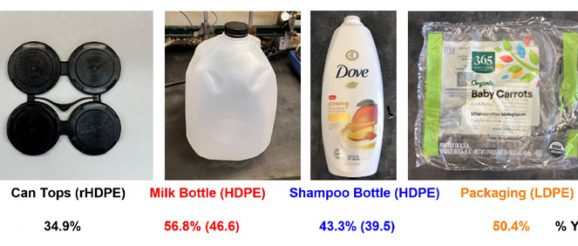The ubiquitous plastic bag that blights the landscape may have finally become recyclable via a new process – Innovation Toronto

Polyethylene plastics — in particular, the ubiquitous plastic bag that blights the landscape — are notoriously hard to recycle. They’re sturdy and difficult to break down, and if they’re recycled at all, they’re melted into a polymer stew useful mostly for decking and other low-value products.
But a new process developed at the University of California, Berkeley, and Lawrence Berkeley National Laboratory (Berkeley Lab) could change all that. The process uses catalysts to break the long polyethylene (PE) polymers into uniform chunks — the three-carbon molecule propylene — that are the feedstocks for making other types of high-value plastic, such as polypropylene.
The process, admittedly in the early stages of development, would turn a waste product — not only plastic bags and packaging, but all types of PE plastic bottles — into a major product in high demand. Previous methods to break the chains of polyethylene required high temperatures and gave mixtures of components in much lower demand. The new process could not only lower the need for fossil fuel production of propylene, often called propene, but also help fill a currently unmet need by the plastics industry for more propylene.
“To the extent they get recycled, a lot of polyethylene plastics get turned into low-grade materials. You can’t take a plastic bag and then make another plastic bag with the same properties out of it,” said John Hartwig, UC Berkeley’s Henry Rapoport Chair in Organic Chemistry. “But if you can take that polymer bag back to its monomers, break it down into small pieces and repolymerize it, then instead of pulling more carbon out of the ground, you use that as your carbon source to make other things — for example, polypropylene. We would use less shale gas for that purpose, or for the other uses of propene, and to fill the so-called propylene gap.”
Polyethylene plastics make up about one-third of the entire plastics market worldwide, with more than 100 million tons produced yearly from fossil fuels, including natural gas obtained by hydraulic fracturing, often called shale gas.
Despite recycling programs — recyclable PE products are designated with plastic numbers 2 and 4 — only about 14% of all polyethylene plastic products are recycled. Because of their stability, polyethylene polymers are difficult to break down into their component parts, or depolymerize, so most of the recycling involves melting it and molding it into other products, like yard furniture, or burning it as fuel.
Depolymerizing polyethylene and turning into proplylene is a way of upcycling — that is, producing higher-value products from essentially zero-value waste, while reducing the use of fossil fuels.
Hartwig and his colleagues will publish the details of their new catalytic process this week in the journal Science.
Two types of catalysts
Hartwig specializes in using metal catalysts to insert unusual and reactive bonds into hydrocarbon chains, most of which are petroleum based. Novel chemical groups can then be added at these reactive bonds to form new materials. The hydrocarbon polyethylene, which typically occurs as a polymer chain of perhaps 1,000 ethylene molecules — each ethylene is composed of two carbon and four hydrogen atoms — provided his team with a challenge because of its general non-reactivity.
CHICAGO—Plastics executives embraced climate solutions at a major industry conference here last week and said they were betting on “advanced recycling” as a green response to the plastic waste problem …
